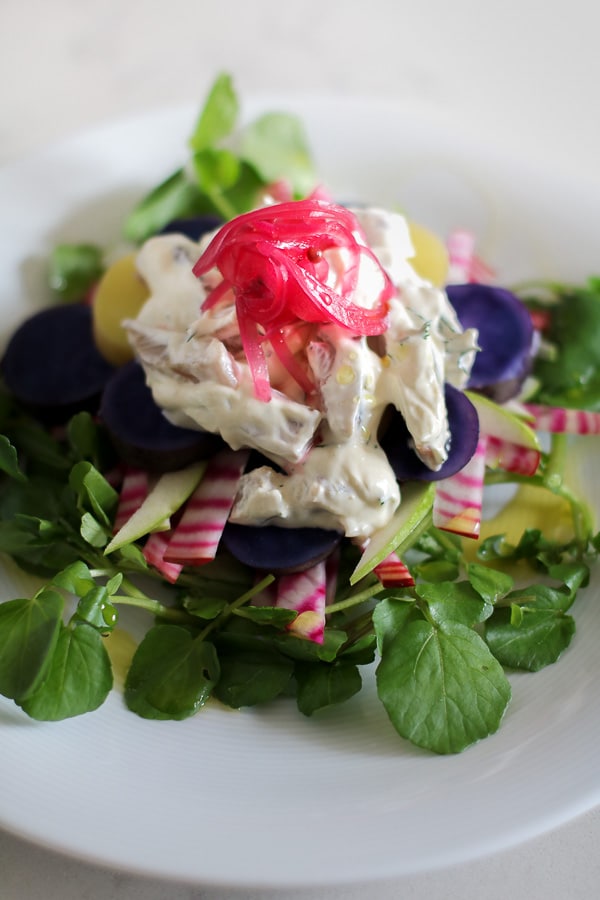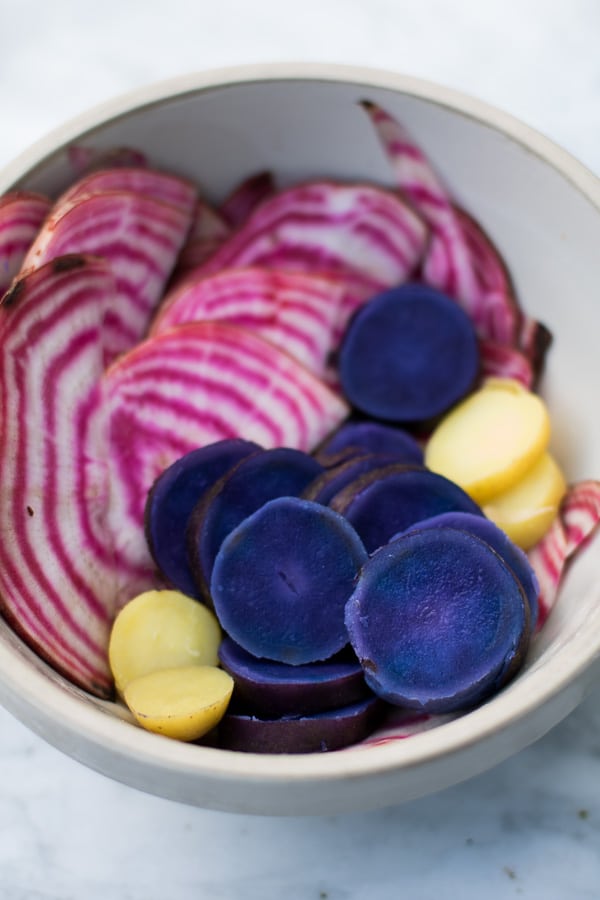
This dish is an ode to my old life in Moscow. I lived there before the sanctions; that one step forward, two steps back time when Russia was courting the West whilst writing the divorce papers. It was intoxicating, and it was finite. Like last call for drinks at a bar, we knew the doors could close at any moment and we took the last round-up straight. Russia sharpened your wits; it made you live, and live hard.
But it’s always been this edgy contrast that’s defined Russia’s rare diamond and it’s the contradictions that bookend every memory: the beggars sitting in the shadows of chandeliers outside marble paved metro stations. The dark, cigarette stubbed soviet stairwells and bulletproof steel doors. The imperial grandeur; candy cane domed towers and neoclassical palaces; point shoes, ballet and Rachmaninov filled concert halls. The toxic stench of enamel paint in the spring as park fences were recoated amidst the delicate perfume of lilac blossom and avenues of birch trees in bud. And the sound of laughter, and ice cubes tinkling in cocktail glasses and the sweet sensation of warm lips kissing the frosty cheeks of friends blown in from the snow. The weekends at country dachas; scorchingly hot banyas and the sting of ice on steamy hot skin as we rolled in the snow under a frozen starlight sky.

Purple French Vitelotte potatoes and small new potatoes.
This dish is based on the classic Russian salad Селёдка под шубой; herring under a fur coat. In its pure form, the salad is a layered mix of sliced pickled herring, grated boiled root vegetables (potato, carrot and beetroot), chopped onions, eggs and mayonnaise. My version, like my memories of Russia, is more about contrast; thin slices of raw Chioggia beetroot, salty herrings, the crisp crunch of a tart Granny Smith apple, peppery watercress and the smooth earthy flavour of purple French Vitelotte potatoes.

Steamed French Vitelotte and new potatoes with sliced Chioggia beetroot.
The local produce markets here in the Béarn are full of new season potatoes at the moment. The stunning Vitelotte potato used in this recipe is an heirloom variety that’s been cultivated in France since the early 19th century. Unlike other purple varieties, they retain their intense violet hue after cooking due to anthocyanin, a powerful antioxidant. Their aroma reminds me a little of chestnuts, also in abundance at the moment.
So revered were the potato’s culinary virtues in France by the late 18th century, it’s said that Louis XVI wore the potato flower in his buttonhole, and Marie Antoinette chose the flowers of the purple potato to adorn her headdress. In fact, it was Louis XVI who granted the military pharmacist Antoine-Augustin Parmentier royal farmland west of Paris to grow the potato. Prior to this, the fate of the potato was altogether different. In 1748, the French parliament issued legislation forbidding the cultivation of the potato, believing it was the cause of leprosy and only fit for pig feed. It wasn’t until 1772, when the Paris Faculty of Medicine finally conceded to Parmentier’s research findings on the nutritional benefits of the potato, that they were deemed suitable for human consumption. Parmentier’s work on promoting the potato was so great that his name not only bears a string of French potato dishes in his honour, but also an avenue in the 10th and 11th arrondissements of Paris and a station on the Paris Métro. Interestingly, it was also Parmentier who was responsible for pioneering the extraction of sugar from sugarbeets.
I’ve used Chioggia beetroot in this recipe, an heirloom Italian variety named after the small fishing village near Venice where they were first cultivated. Unlike the Vitelotte potato, they don’t retain their intense candy cane stripes after cooking which is why I’ve used them raw. Although they’re sweet, they have a bite to them, so they need to be sliced finely with a mandoline and used as a garnish rather than a major ingredient; think of them as a tower of St Basil’s Cathedral; an embellishment, not a structural component.
There’s a natural affinity between herrings and vodka. This salad, in its original form, is typically served as a snack or starter and almost always, with vodka to cut through the cream and salt. However, Herrings in a Technicolour Dreamcoat, is, after all, a French hybrid version so I consulted my friend Jamie Hutchinson from London’s The Sampler for a wine selection. His advice was thus:
‘Match it with an Albarino. It needs to be citrusy and fresh to match the flavours, but with just a hint of weight to balance it texturally.’ And his suggestion—Arousana Follas Novas 2015 from Rias Baixas,Spain

My husband and I celebrated one of our last nights in Moscow at a party with friends in a typical Muscovite apartment. It was late when we left and Sammy Davis Junior’s Mr Bo Jangles was playing. As the Soviet steel door closed behind us, we knew we were walking out of a scene in Russian history that would never be repeated; one we probably never had any business being part of in the first place, but it was good. It was so, so good.
This is for the friends I left behind and the others, now scattered all over the globe.
На здоровье.
Russian Herring Salad, traditionally known as “Shuba” or “Herring Under a Fur Coat,” is a classic layered salad popular in Russian cuisine, especially during festive occasions. The salad consists of layers of pickled herring, boiled vegetables, eggs, and mayonnaise, culminating in a vibrant beetroot topping that resembles a fur coat.
Ingredients:
-
2 medium beets
-
2 medium Yukon Gold potatoes, peeled (I used violet)
-
2 medium carrots, peeled and halved crosswise
-
2 large hard-boiled eggs
-
1 cup finely chopped pickled herring
-
1/4 cup diced onion
-
1/4 cup canola oil
-
2 tablespoons chopped fresh dill, plus sprigs for garnish
-
1/2 cup mayonnaise
-
Kosher salt, to taste
Instructions:
-
Prepare the Vegetables:
-
Place the beets, potatoes, and carrots in a medium saucepan. Cover with water and add a pinch of salt. Bring to a boil, then reduce the heat and simmer until tender, about 20-25 minutes for potatoes and carrots, and 30-35 minutes for beets.
-
Once cooked, drain and let the vegetables cool to room temperature.
-
Peel the beets, potatoes, and carrots. Grate them separately using a coarse grater.
-
-
Prepare the Eggs:
-
Grate the hard-boiled eggs using a coarse grater.
-
-
Assemble the Salad:
-
In a medium bowl, combine the chopped pickled herring, minced onion, canola oil, and chopped dill. Mix well.
-
On a serving platter, create a base layer with the grated potatoes, spreading them evenly.
-
Spread the herring mixture over the potato layer.
-
Evenly distribute the grated carrots over the herring layer.
-
Spread a thin layer of mayonnaise over the carrot layer.
-
Evenly distribute the grated beets over the carrot layer.
-
Spread a thin layer of mayonnaise over the beet layer.
-
Evenly distribute the grated eggs over the beet layer.
-
Spread a thin layer of mayonnaise over the egg layer.
-
-
Chill and Serve: Cover the assembled salad and refrigerate for at least 4 hours, or preferably overnight, to allow the flavours to meld.
-
-
Serve on a bed of watercress, garnish with dill sprigs. I like to slice cold potatoes and raw beetroot as a garnish but this is not traditional, nor is the watercress.
-
Serving Suggestions:
Serve chilled as an appetiser or side dish. This salad pairs well with quick pickled onion for a garnish, rye bread or If you’re in France, toasted baguette slices.

+ ADD A COMMENT